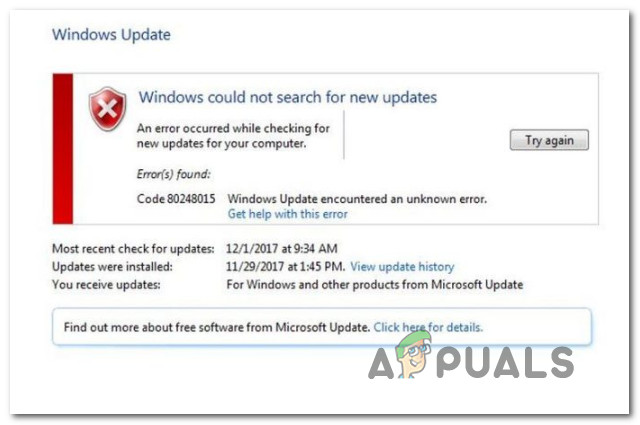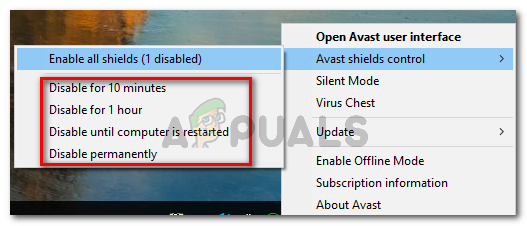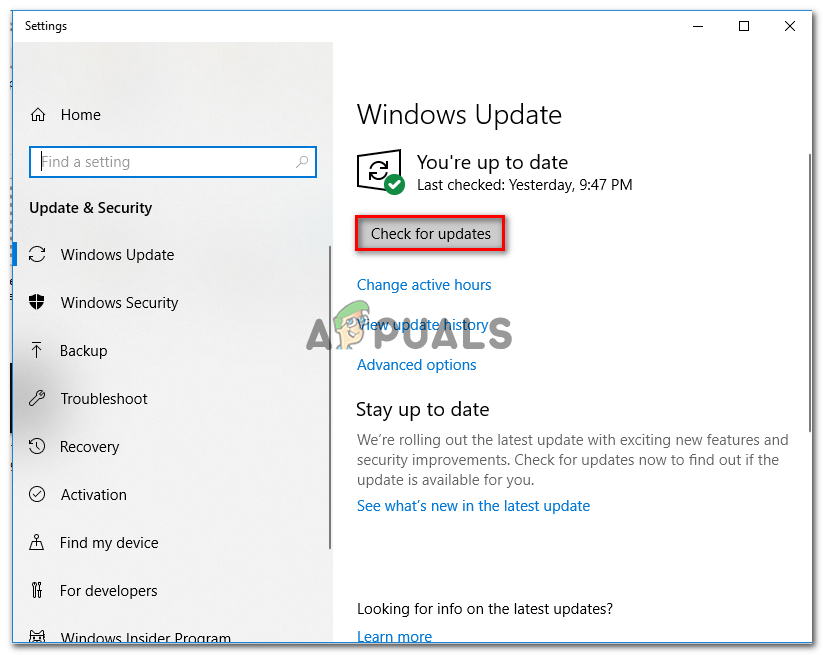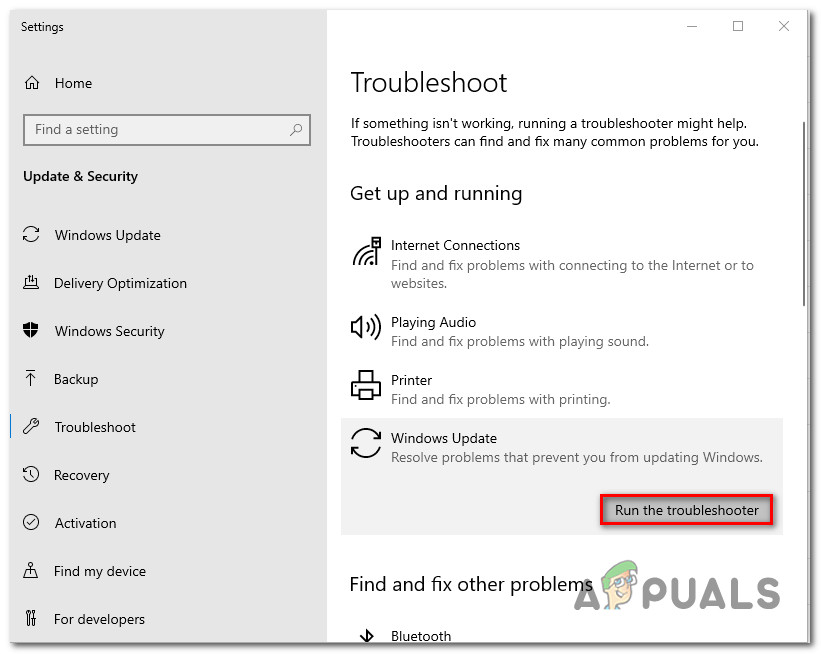How to Fix Windows Update Error 80248015
Several Windows users are suddenly unable to install one or more OS updates. The error code that comes up is 80248015. This issue was reported to happen in the past (two years ago) and was fixed by MS, but it seems like it has resurfaced with a couple of newer updates. The problem is confirmed to appear on Windows 7, Windows 8.1 and Windows 10.

What is causing the Windows Update Error 80248015?
We investigated this particular problem by looking at various user reports and the repair strategies that are commonly being used to fix this failing Windows Update error. As it turns out, there are several different culprits that might be responsible for the apparition of this issue:
- 3rd party AV conflict – There are certain 3rd party security suites that are known to inhibit Windows Update from installing certain updates. If this scenario is applicable, you will be able to fix the issue by disabling the real-time protection or by uninstalling the 3rd party security suite.
- Windows Update glitch – There was one bad update released at the beginning of 2018 that ended up producing this error code. But since then, Microsoft released a hotfix for it. To take advantage of it, install every pending update and then install the problematic update last.
- WU file corruption – It’s also possible that the issue is being caused by some degree of file corruption that is stopping the WU component in its tracks. If this scenario is applicable, you should be able to resolve the issue by fixing the issue with the Windows Update troubleshooter or by resetting all WU components manually from an elevated Command Prompt.
Method 1: Disable 3rd party AV suite (if applicable)
More often than not, the culprit that is causing the issue turns out to be an overprotective 3rd party security suite. There are certain security solutions that are known to inhibit the updating function of WU by blocking certain ports used by the Windows Update component.
If this scenario is applicable to your current situation, you should be able to resolve the issue by disabling the real-time protection of your 3rd party antivirus or by uninstalling the security solutions completely.
If you want to go the soft route, you can simply access your AV settings, disable the real-time protection and try to update again. If doing so lets you install the update without encountering the 80248015 error, you’ve successfully fixed the issue while identifying the culprit.

If the issue is still occurring, you can also try to remove the security completely while making sure that you’re not leaving any remnant files and restart your computer. If you decide to go this route, you can follow our step by step article (here).
If this method wasn’t applicable to your situation or it didn’t resolve the issue permanently, move down to the next method below.
Method 2: Installing every other pending update automatically
As mentioned above, Windows already released for the issue that was causing several security updates to fail. This hotfix will be deployed automatically on all Windows versions (7, 8.1 or 10) provided that you have a genuine license key.
To install the hotfix, simply install every pending Windows update the is currently waiting to be installed. Here’s a quick guide on doing this:
- Press Windows key + R to open up a Run dialog box. Then, type ”ms-settings:windowsupdate’ and press Enter to open up the Windows Update tab of the Settings app.

Opening the Windows Update screen Note: If you’re using Windows 7 or Windows 8.1, use the ‘wuapp’ command instead.
- When you’re inside the Windows update screen, click on Check for updates, then follow the on-screen prompts to install every Windows update that is currently scheduled to be installed. Install every type of update including cumulative and scurity updates, not just important ones.

Installing every pending Windows update Note: Avoid the problematic update for now and install everything else!
- If you have a lot of pending updates, chances are you will be prompted to restart before every update is installed. If this happens, do so but make sure to return to this screen at the next startup and finish the installation of the rest of the updates.
- Once every pending update is installed, restart your computer one final time and see if the issue has been resolved once the next startup sequence is complete.
If the Windows Update Error 80248015 is still appearing when you try to install the problematic update, move down to the next method below.
Method 3: Running the Windows Update troubleshooter
Several affected users have reported that they managed to resolve the issue by running an automated built-in utility capable of fixing issues of this kind automatically.
Windows Update troubleshooter holds a collection of repair strategies that are capable of fixing most of the common culprits that can be responsible for a failed windows update. This tool will analyze WU components for any inconsistencies and apply the appropriate repair strategy if a problem is identified.
Here’s a quick guide on resolving the Windows Update Error 80248015 by using the Windows Update troubleshooter:
- Press Windows key + R to open up a Run dialog box. Next, type “ms-settings:troubleshoot” and hit Enter to open up the Troubleshooting tab of the Settings app.

Accessing the Troubleshooting tab - When you’re inside the troubleshooting screen, scroll down to the Get up and running tab. Next, click on Windows Update and then select Run the Troubleshooter from the newly appeared context menu.

Running the Windows Update troubleshooter - Once you launch the troubleshooter, wait until the initial analysis is complete. If a suitable repair strategy is found, you will be prompted to apply the suitable fix. Do so by clicking on Apply this fix.

Apply this fix - When the fix has been applied, restart your computer and see if the issue has been resolved at the next startup by trying to install the problematic update.
If you’re still encountering the Windows Update Error 80248015 while trying to install it, move down to the next method below.
Method 4: Resetting WU Components
If none of the methods above have helped you in resolving the Windows Update Error 80248015, resetting the entire suite of components involved in the updating process seems to do the trick for most users struggling with this error.
Follow the steps below to reset all WU (Windows Update) components manually by using an elevated Command Prompt:
- Press Windows key + R to open up a Run dialog box. Next, type “cmd” and press Ctrl + Shift + Enter to open up an elevated Command Prompt with admin access

Running CMD as an administrator Note: When prompted by the User Account Control (UAC) window, click Yes to give admin access.
- Once you’re inside the elevated CMD window, type the following commands in order and press Enter after each one.
net stop wuauserv net stop cryptSvc net stop bits net stop msiserver
Note: These commands will stop the Windows Update Services, MSI Installer, Cryptographic services, and BITS services.
- Once all services have been disabled, run the following commands in the same elevated CMD window to rename the SoftwareDistribution and Catroot2 folders:
ren C:\Windows\SoftwareDistribution SoftwareDistribution.old ren C:\Windows\System32\catroot2 Catroot2.old
Note: These folders are responsible for storing the update files used by the WU component, so it’s crucial to rename them in order to force WU to create new instances.
- Next, type the next series of command in order and press Enter after each one to restart the services that we previously stopped:
net start wuauserv net start cryptSvc net start bits net start msiserver
- Once the services are restarted, close the elevated Command prompt and attempt to install the update again.





